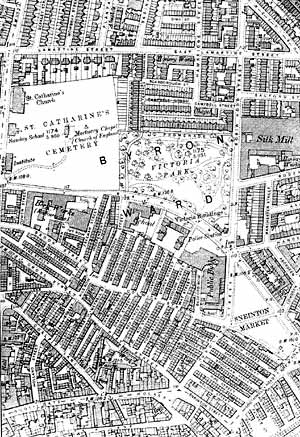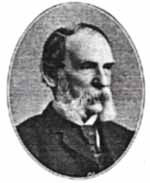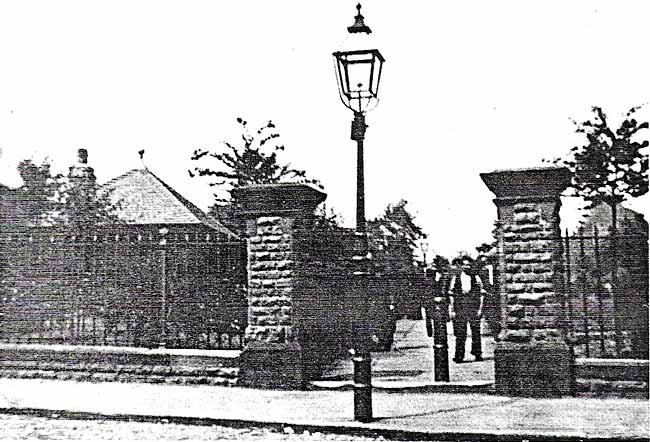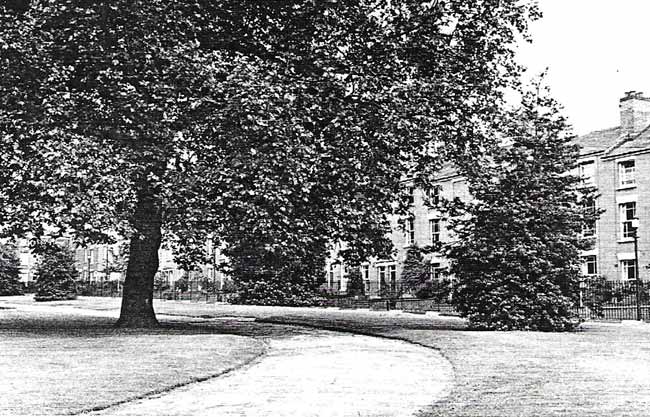< Previous
THE MAKING OF VICTORIA PARK :
Part 2 : 'Tastefully laid out walks'
By Stephen Best
Part 1 described the day-to-day difficulties of Bath Street Recreation Ground, leading up to the taking of the decision to landscape it completely.
 VICTORIA PARK at the turn of the century; the densely built up nature of the neighbourhood is plain to see.
VICTORIA PARK at the turn of the century; the densely built up nature of the neighbourhood is plain to see.IN FEBRUARY 1892 the Public Parks Committee were shown four schemes for an improved ground. One of these was submitted by local ward representatives. They suggested lowering the ground at one end by 7 or 8 feet, to reduce the fall in the surface level; building a Bulwell stone wall along the north and west boundaries; and putting in an efficient system of drains to prevent water washing sand into adjacent streets during heavy rainfall. The cost of such improvements was estimated to be about £2,500. Two other schemes were less expensive; one was for the whole ground to be roughly levelled and then asphalted, at a cost of some £2,100, while another suggested that a plantation be formed at the north and west sides of the ground, after the sandstone rock had been hacked up; this was expected to involve an outlay of around £1,000. All three of these schemes were, however, rejected in favour of the Borough Engineer's plan. He proposed a wide shrubbery along the north and west sides, ornamental beds and walks in the turfed interior of the ground, and a large asphalted children's play space, furnished with swings, near the Bath Street entrance. It was calculated that these works would cost £3,000. The Committee resolved to recommend this scheme to the full Town Council, believing that this was the only effectual way forward if the Council was 'desirous of making any permanent improvement in this ground'.
The Council agreed with this view, and its Finance Committee sought the consent of the Local Government Board for a loan to pay for the works. The Borough Engineer again discussed his plans with the Public Parks Committee, who found that some last minute alterations were needed. They decided to enclose the whole ground by an iron palisade fence, with entrance gates, which would be closed at night. In the light of this decision, a footway was ordered to be made across the ground, next to the burial ground wall; this was to be kept open at night for the convenience 'of persons desirous of crossing the ground'. The Engineer was instructed to obtain tenders from likely contractors, while the pressing need for new works was in the meantime emphasised by the receipt of a letter from the solicitors Wells and Hind, on behalf of owners of adjacent properties, complaining yet again about the condition of Bath Street Recreation Ground.
The tenders came in, with three separate contracts to be awarded. The lowest estimate for the stonework was £203.7.0d, by James Thomas of Park Wharf, Lenton Boulevard (now Castle Boulevard). Raybould & Co of Workington submitted the lowest bid for the ironwork contract, £360, undercutting several well-known local firms, including Walter Danks & Co., Thomas Danks & Co., and G. R. Cowen & Co., of the nearby Beck Works. The Public Parks Committee, however, seem to have smelt a rat here, offering the job to Rayboulds subject to satisfactory evidence of their ability to carry out the work in 'a good and workmanlike manner'. If this was not forthcoming, then W. H. Raynor of London Road, Nottingham, who had sent in a tender of £458.18.8d, would be given the contract. As for the third contract, for gardeners' work, William Bardill, the man in possession, submitted a tender of £l,361.2.4d, substantially less than that of Thomas Toop of Hucknall Road, Carrington, who priced the job at £1,608. The following month, December 1892, Rayboulds wrote, declining to carry out the work 'as per tender', and asked if they might submit a revised one. The Committee would have none of this, and resolved to accept Raynor's tender instead. Mr J. H. Bardill informed the Committee that his father had died, asking that, as executor, he be allowed to carry out the gardening contract.
Inevitably, it now seems, there was further delay in starting the ground improvements. This was caused by the Local Government Board withholding its consent to the necessary loan. The Town Clerk wrote to the Board, urging the speedy granting of this consent, so that work might be begun in the winter, and so to help to find employment for a number of the men currently out of work in Nottingham. Indeed, a deputation from Nottingham United Trades Council attended the Committee meeting on February 20 1893, urging that the town's unemployment plight required a prompt start to the project. The Town Clerk had by now received a telegram from the Board, indicating that consent for the loan would be given in due course, and it was resolved that, under these circumstances, the job was to be proceeded with at once.
Work went ahead throughout the year, Arthur Brown making necessary amendments as it progressed; a shrubbery alongside the Bath Street boundary: the swings to be resited in a more convenient position: and strong wire netting to be fixed to the iron boundary fences. It is not easy to imagine, at this remove in time, just how much levelling of the ground was needed to turn it into what we know as Victoria Park. Even now, when one instinctively thinks of the park as a level expanse of ground, it comes as a surprise to look at the site, and realise how much of a slope still exists today. What the conditions can have been like before levelling and draining, one can only conjecture; they must, at any rate, have been good enough for the playing of cricket matches for half a century.
Early in 1894, it was decided that the remodelled Bath Street Recreation Ground was to be opened during the first week in May, and Thursday May 3 was later fixed upon. What subsequently caused the event to be moved to Monday the 7th, one does not know, but the local press of May 8 1894 was, at long last, able to report the news of the opening of the new park.
The Nottingham Daily Guardian was fulsome in its praise: 'The transformation of the old Bath Street playground, which had for years been an eyesore to that particular portion of the Sneinton district, into tastefully laid out walks, grass lawns, and shrubberies, provision also being made for the children in the matter of swings and other means of recreation, and which is henceforth to be known by the title of 'The Victoria Park', is one that cannot fail to meet with the fullest appreciation, not only of the residents in the immediate neighbourhood, but of the town generally.' The Guardian went on to describe how the landscaping work, carried out by Bardills to Arthur Brown's designs, would prove to be a most acceptable improvement to the town's amenities. As was usual on such occasions, there was a considerable attendance of Borough notables. Not only was the Mayor, Alderman Pullman, present, but others on hand included Alderman Lambert, chairman of the Public Parks Committee, and a dozen other members of the Town Council. Councillor Gregory and John Sharkey, who had both done much to press for the improvements to the recreation ground, were among those invited. Ald. Lambert recalled that the land had been allotted to the Corporation as a playground in the 1845 Enclosure Act, but pointed out that so much use had been made of it that it soon became totally bare, without a single blade of grass. He paid tribute to Mr Sharkey, who, he said, deserved the credit for promoting the improvement scheme while he was a member of the Town Council. Sharkey, a wine merchant, might well have reflected that his diligence on behalf of the community had done him precious little good, he having been defeated by a Conservative opponent in the 1893 election for Byron Ward. Mr Sharkey's fellow Liberal, F. W. Gregory, had, by contrast, been returned unopposed in 1892; Gregory was a pawnbroker and clothier of St Ann's Well Road and Long Row.
 Ald. William Lambert, J.P. The chairman of the Public Parks Committee when the Victoria Park was opened.
Ald. William Lambert, J.P. The chairman of the Public Parks Committee when the Victoria Park was opened.The Mayor, greeted with applause, spoke next, saying how pleased he was that this occasion should occur during his year of office. Alderman Pullman observed that he had known the area intimately for many years, and had always felt that improvements were required at the recreation ground. He congratulated all concerned in the remodelling, and declared the ground open, naming it Victoria Park. The Evening News added a few extra details. The ceremony had begun with members of the Corporation assembling outside the main entrance at half past three, and in his speech Alderman Lambert expressed the opinion that the £3,000 expended on the improvements was money well spent. 'He hoped the people in the neighbourhood would value the new ground and prevent damage being done, and that order would be maintained..... The inhabitants of the neighbourhood ought to be thankful to Mr Sharkey for the persistence with which he had advocated the laying out of the ground'. The Mayor added his own appreciation of John Sharkey, for the interest he had taken in the welfare of that part of the town.', and hoped that people 'would derive considerable benefit from the improvement'. The Evening News report imparts an air of excitement to the proceedings; A very large crowd, numbering several thousand persons, awaited the opening of the gates with evident interest, and as soon as the gates had been thrown open the grounds were thronged, the younger people making immediately for the swings which were kept going all night.' It is likely that the authorities had been concerned about possible unruliness at the opening, but all was, in the event, without mishap, the Evening Post recording that the police arrangements were 'admirably carried out by Chief Superintendent Lamb'.
A word ought to be said about the name chosen for the remodelled park. No mention of this appears in the Council or Committee minutes before May 21 1894, and, indeed, the first that people knew of it seems to have been when they heard Alderman Pullman make his announcement at the opening. That it was a personal whim of Pullman's must be doubted, so it may be concluded that the Public Parks Committee, in consultation with other senior members of the Council, had hit upon the new name. The Queen's name was, of course, frequently bestowed upon public buildings, works, and streets, though she was by no means as universally venerated as we are now inclined to believe. In this case, however, it is very likely that the presence of Victoria Buildings across Bath Street suggested a suitable name for the greatly improved park. The rebuilt and enlarged public baths a few yards away, which were opened in the mid-1890s, also continued the Royal theme, giving the immediate locality three landmarks bearing the monarch's name.
 THE PUBLIC RIGHT OF WAY across Victoria Park, looking from Bath Street.
THE PUBLIC RIGHT OF WAY across Victoria Park, looking from Bath Street.So this part of Nottingham acquired its new pleasure ground. This satisfied a real need, for it has to be remembered that a century ago the Bath Street Rest Garden was still a cemetery, so not an accepted or, indeed, permitted, place for leisure activities. Nor did King Edward Park yet exist; its present-day site in Carlton Road was in 1894 covered by the gardens and grounds of the Lunatic Asylum. Close to Victoria Park was a large and densely-packed population; the land between Bath Street and what is now Lower Parliament Street was packed with back-to-back dwellings, as was the area later occupied by Sneinton Wholesale Market. The streets between Robin Hood Street, Alfred Street, and Carlton Road also contained many workingclass homes. Across St Ann's Well Road, opposite the end of Bath Street, was a tract of streets and courts, later pulled down at various times to make way for Trumpet Street Power Station (whose buildings survive at this time of writing) or Huntingdon Street Bus Station. Beyond this area lay St. Michael's Recreation Ground, the nearest recreation ground to Victoria Park, but with another teeming mass of residents on its doorstep. On either side of Sneinton Road, and on the site of Parliament Street Bus Depot, was a further warren of small streets and yards, many containing houses which, even then, were becoming considered unfit for habitation. In addition, both St Ann's Well Road and Robin Hood Street were flanked by streets of terrace housing which would last until the St Ann's redevelopment of the 1960s and 1970s. The houses surviving near Victoria Park today, in Promenade, Campbell Grove, Lamartine Street, and the like, exemplified the very best housing conditions in the district. With such a crowded population, crammed into what was, in so many places, seriously sub-standard housing, it is not surprising that there were outbreaks of misbehaviour in the recreation ground that had called for the presence of the police.
Inevitably, such incidents were to continue. Within a year of the hopeful and confident opening of the transformed Victoria Park, the Public Parks Committee were again obliged to ask the Watch Committee 'to have a constable stationed at this Recreation Ground for the purpose of assisting the caretaker to keep order, and prevent damage being done by unruly boys'. Though the park had changed, the neighbourhood, with all its attendant problems of poverty and petty crime, had not.
It was remarked at the beginning of this short narrative that Corporation minutes and reports help us to appreciate the rich intricacy of municipal activity in Victorian Nottingham. As also hinted earlier, they should also assist in banishing the figment of a time when nobody locked their front doors, when passers-by walked any street at night unmolested, and when children, under daily threat of flogging at home or school, invariably behaved themselves. As an examination of contemporary newspapers suggests, many of Nottingham's inhabitants passed their lives without ever being aware that they lived through such a Golden Age.
 VICTORIA PARK today; overlooked as it was at the time of our story, by the houses of Promenade.
VICTORIA PARK today; overlooked as it was at the time of our story, by the houses of Promenade.The story of Victoria Park in the twentieth century is equally eventful, and may be told at a later date. I am indebted to Nottinghamshire Archives Office for access to relevant Corporation documents, and to Nottinghamshire Local Studies Library for other material. My thanks also go to John Washbrook, of Nottingham City Council Environmental Services Department, for information about the Beck Valley Culvert.
< Previous
